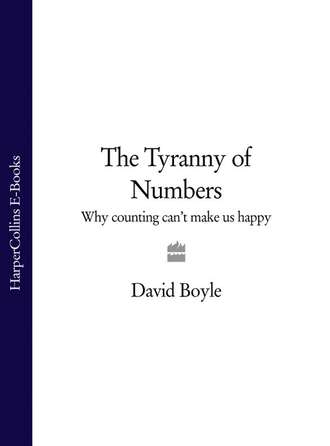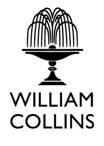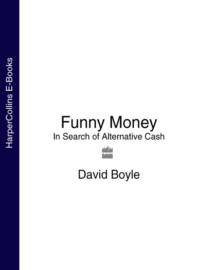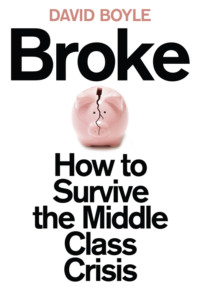
Полная версия
The Tyranny of Numbers: Why Counting Can’t Make Us Happy

THE TYRANNY OF NUMBERS
Why Counting Can’t Make Us Happy
David Boyle

Contents
Cover
Title Page
Dedication
Introduction: Still Life with Numbers
Chapter 1: A Short History of Counting
Chapter 2: Historical Interlude 1: Legislator for the World
Chapter 3: Elusive Happiness
Chapter 4: Historical Interlude 2: Commissioner of Fact
Chapter 5: The Feelgood Factor
Chapter 6: Historical Interlude 3: Social Copernicus
Chapter 7: The New Auditors
Chapter 8: Historical Interlude 4: National Accountant
Chapter 9: The New Indicators
Chapter 10: Historical Interlude 5: The Price of Everything
Chapter 11: The Bottom Line is the Bottom Line
Postscript
Keep Reading
Index
Acknowledgements
About the Author
Also by the Author
Copyright
About the Publisher
Dedication
For Joanna, Ben, Agatha and Frances
Introduction
Still Life with Numbers
The renowned cosmologist Professor Bignumska, lecturing on the future of the universe, had stated that in a billion years according to her calculations, the earth would fall into the sun in a fiery death. In the back of the auditorium a tremulous voice piped up. ‘Excuse me Professor, but h-how long did you say it would be?’ Professor Bignumska calmly replied, ‘About a billion years.’ A sigh of relief was heard. ‘Whew! For a minute there, I thought you said a million years.’
Douglas Hofstadter, Scientific American, May 1982
There are no such things as still lifes.
Erica Jong
I
Mary Poppins was the first film I ever saw. I was six years, four months old – let’s measure it precisely. I remember trotting as fast as I could beside my father along Whitehall, past the Treasury and the other palaces of national calculation, to the Haymarket. I remember the strange red torches and the national anthem at the end. That’s how it was in those more deferential and innocent days before the hippies. And I remember being completely blown away by the experience, the songs of Julie Andrews and the idea that life should be a little more magical than it was.
Within weeks I knew most of the lyrics by heart, though I barely understood the words. Maybe, in retrospect, I was also a little influenced by Mary Poppins’ ridicule of George Banks – Hollywood has recycled the name George Banks for pompous boobies ever since – and his fascination for the kind of order brought by numbers. ‘They must feel the thrill of totting up a balance book,’ she sings to poor deluded George about his children:
… A thousand cyphers neatly in a row.
When gazing at a graph that shows the profits up,
their little cup of joy should overflow.
The irony is lost on him – as it was on me. And though Hollywood is still busily promoting the idea of magic, you would never catch them in this post-Thatcherite age making fun of profits or ridiculing the vital importance of calculation – still less the idea of cyphers neatly in a row. It’s just too important to us all these days.
So I came away from the cinema determined to make sure I flung my tuppence away on some little old bird woman, rather than marvelling at the strange alchemy of compound interest if I put it in the bank. I was not going to be a George Banks. Yet here I am, 35 years later, with my pension and life insurance, living in a world completely overwhelmed by numbers and calculation.
It’s the same for nearly all of us. There are personal calculations to be made each day, about investments, journey times, bank machines and credit cards. There are professional figures at work, in the form of targets, statistics, workforce percentages and profit forecasts. As consumers, we are counted and aggregated according to every purchase we make. Every time we are exposed to the media, there is a positive flood of statistics controlling and interpreting the world, developing each truth, simplifying each problem. ‘Being a man is unhealthy,’ said the front page of the Evening Standard recently, adding – like every similar newspaper article about statistics – the word: ‘official.’ As if we had been wondering about the truth all these years and, thanks to the counters, we now know. As if the figures are so detached that there is no arguing with them.
But of course we keep arguing. Just as the government keeps arguing despite its battery of benchmarks, quality indicators and league tables, as it struggles to hold back chaos like King Canute in front of the waves. We take our collective pulses 24 hours a day with the use of statistics. We understand life that way, though somehow the more figures we use, the great truths still seem to slip through our fingers. Despite all that calculating, and all that numerical control, we feel as ignorant as ever.
Mary Poppins might have been talking about me when she said that ‘sometimes a person we love, through no fault of his own, can’t see past the end of his nose’. She meant George Banks, of course, but I feel just as myopic myself. Life never keeps still long enough to measure anything important.
If you are said to be ‘calculating’, people could mean one of two things about you – both related and equally repellent. It could mean that you are constantly comparing what is best for you in any given situation. This is not a compliment. It implies something cold, fish-like and completely self-interested. But it could also mean you are someone who counts too much, someone who measures things but can’t see the reality behind them.
There is something equally clinical about that, but disinterested rather than self-interested. A calculating person, in this sense, is someone for whom the world past the end of their nose is a foreign country. And although we have become exactly that with all our counting, and increasingly so, it can send a shiver down the spine when you come across extreme examples. Like the eighteenth-century prodigy Jedediah Buxton, in his first trip to the theatre to see a performance of Shakespeare’s Richard III. Asked later whether he’d enjoyed it, all he could say was that there were 5,202 steps during the dances and 12,445 words spoken by the actors. Nothing about what the words said, about the winter of our discontent made glorious summer; nothing about the evil hunchback king.
Today, Buxton would probably be described as autistic. It is particularly horrifying to hear that his numbers turned out to be exactly right.
The story is funny now as then, but it is also faintly disturbing, and I have been wondering why this is. It could be that we see Jedediah Buxton as a fearsome symbol of the modern age, counting everything but seeing the significance of nothing. But I think it is deeper than that. There is something inhuman about it – not so much the ability to count, but the failure to be moved. We shiver, I think, at anybody with no emotions – as if they were completely amoral, like Dr Strangelove. We shrink from white-coated doctors too like cold calculating machines. Even doctors should be slightly fallible.
Even so, we encounter these ‘calculating’ machines almost every day. It’s hard not to turn on the news without audibly tripping over one of them. Like the academic who refuses to pass judgement on any problem, however urgent, because there hasn’t been enough research. Or the politician who is so obsessed with the polling figures that he can no longer trust his gut instincts. Or the social scientist who has laboriously proved with the use of statistics something which anybody else with an ounce of common sense knew already – that the death of a parent can scar a child for life, or that alcoholics have an unusually high depression rate. It’s official, they say. Like the University of Michigan study which revealed that children who don’t take exercise and eat junk food tend to be fatter. Or the recent research which showed that areas of high unemployment tend to have fewer jobs.
Then there are the familiar people who muddle up the numbers with the truth. Or, even worse, those who think you can change the truth just by changing the statistics. Don’t forget those dismal agriculture ministers who urged the public to listen to the scientists over the safety of BSE beef (and really believed it) even though they were quietly suppressing the research of anybody who argued that it might not be safe to eat.
These are modern monsters, but none of us can completely escape the accusation. We’re all tied up with figures, even if they are just cricket averages and lottery numbers.
Romantics and leftists traditionally say this is a bad thing. Romantics think that it reduces the individual to mere figures. Leftists think it’s a kind of tyranny. They are both wrong in the sense that we do need to be able to count – but they are right too. The strange thing is that ratcheting up the calculations has often been done for excellent humanitarian reasons, driven by impeccably radical reformers. Of course in the history of the tyranny of numbers over life there are crazed scientists and Nazis with branding irons who stalk through the pages. This is no scientific history of counting, and there is no account of the great statistical pioneers like Herbert Spencer or Karl Pearson. Nor does it cover the byways of scientific research or IQ – or the people who really believed you could control individuals by counting them.
But counting was also a way of improving the world. Maybe they wanted to prove the existence of great inequality or disease, like Edwin Chadwick. Maybe they wanted to find a way of aggregating the national accounts to defeat Hitler, like John Maynard Keynes. Or maybe they wanted to force politicians to worry about people’s happiness, like Jeremy Bentham. All the historic interludes I’ve chosen in this book fall into that category. They are people who – for the best of motives – brought forth the flood of numbers and calculations into the non-scientific parts of our lives.
It still is a way of improving the world. Are your schools not performing as well as they should? Then measure their results. Are you worried about the performance of a local council, a company, a great institution, a hospital? Send in the auditors, set some standards as benchmarks. You don’t trust the professionals? Summarize their decisions in number form, send in the cost-benefit experts and keep your beady eye on them. It is the modern way. Numbers – like money – drive out the mysterious power of elites, the clubbable atmosphere of the professions, the we-know-best patronizing attitudes of those thick-set people with glasses and firm handshakes who used to lord it over our lives. We can control them if we can reduce their complex professionalism to numbers.
The trouble is that the numbers have proliferated, and it’s sometimes hard to breathe – still less tell the difference between one statistic and another. It is difficult enough to remember your car registration number, PIN number, home, work and mobile phone numbers all at the same time. It’s almost enough to make you coldly calculating.
II
If you want to watch people who go further than that – people who try to measure things which can probably never be measured – then come with me for a moment to the closing minutes of a libel action at the Law Courts in the Strand, London. The jury has decided that when a national newspaper described a respectable lady as a prostitute – when she was no such thing – they had clearly ‘lowered her in the estimation of right thinking people,’ which is one legal definition of libel. But what kind of damages should she be given?
The amount awarded is a decision for the jury, and the judge is not allowed to even hint at a figure. He cannot suggest to them that the average pay-out might be £10,000 or £500,000. His half-moon spectacles perched on the end of his nose, he turns to the jury box. ‘Imagine if you will,’ he says, ‘a small flat in Battersea. Or perhaps a semi-detached in Maida Vale. Or maybe a penthouse apartment in Mayfair …’
And so he goes on. Did the humiliation the woman received deserve the flat, the house or the penthouse? Or something else? How could you start to measure such things? But the jury played safe and plumped for the house, and who can say whether they were right or not? ‘If this is justice, I’m a banana,’ said the editor of Private Eye famously with damages of £600,000 awarded against him in the same court. Damages are notoriously difficult to judge, but sometimes you still have to try.
Libel damages are just one example among many. What makes this such a peculiar moment in the history of measurement is that in almost every area of public life, qualities like happiness, competence or loyalty are being picked over by hordes of radical accountants and politicians, visionary entrepreneurs and planners – desperately trying to find ways of being more effective in a competitive world.
Despite the proliferation of measurements, somehow the numbers are still not providing an effective lever. Why? Because, so often, you can’t measure what’s really important. But it’s all very well to say it is impossible: decisions still have to be made – and if you don’t count what’s really important, it gets ignored. It doesn’t count. There are only so many resources, so doctors must compare the quality of life of a 70-year-old with heart failure against a suicidal teenager with a long history of depression. Planners have to compare the pleasure and disruption brought by a new 18-screen cinema with the contentment of keeping the site as a park. Investors have to compare a notoriously polluting oil company with a dodgy record in human rights with a tremendously successful Internet company with three employees and no profits.
It’s impossible of course, but they have to try, because otherwise the wrong decision will be made or their rivals will steal an advantage. So they find themselves isolating something which can be counted. Then they measure, measure, measure, knowing that what they measure is alive and will not keep still, and suspecting that maybe – however much they count – they will not capture the essence of the question they are asking. Things have to keep static if you’re going to count them: that’s probably why the first statisticians were known as ‘statists’. But real life isn’t still.
How, for example, can businesses measure what they are worth, when value is increasingly ephemeral – encompassing things which go way beyond traditional balance sheets? How can we measure our national or local success when our measuring rods are so inadequate, and yet so important to our politicians? Yet without measuring rods, it is hard to know whether we are making any progress.
But if politicians have a difficult time, it is nothing to what is happening in the business world, as managers struggle to find ways of measuring customer loyalty, brand reputation or staff morale. And as they do so, Internet companies which have never made a profit and which sell intangible products, rush past them up the Wall Street indices. When the balance sheets of a company like Microsoft show assets worth only 6 per cent of its stock market value, they need to find an answer.
It’s all a bit like a computer game. What really matters can’t be counted, but it’s a much worse situation than that. If you make the attempt but measure the wrong thing, it isn’t just wasted effort. It can destroy everything you’ve worked for. Like the school league tables that make teachers concentrate on getting borderline pupils through at the expense of their weaker classmates. Or the hospital waiting lists that fell because only quick simple problems were treated. It’s a familiar story, just as unemployment statistics bear no relation to the number of people who actually want to work. It all comes down to definitions: governments prefer to count people claiming benefits rather than unemployed people. To count things, you first have to define them in measurable ways, and magically the system can manipulate the figures by narrowing the definition.
This amounts to a kind of crisis. We need answers, but we also know that what is most important to our lives simply can’t be pinned down like a still life. We can’t measure happiness directly, any more than we can measure God or measure life, but we can measure some of its symptoms, and some of the symptoms of its absence. Which is why a city like Seattle started measuring success by the number of vegetarian restaurants, or why Strathclyde started measuring success by the number of golden eagles. It is why schools are trying to measure their pupils’ self-esteem, why investors are measuring the ethics of their investments – and why companies like Toys Я Us and Shell are pouring resources into measuring the knowledge and contentment of staff, communities and stakeholders.
A century and a half ago, the followers of the philosopher Jeremy Bentham were dashing around the country in their stagecoaches to measure everything they possibly could – from the health of slum inhabitants to the religious feelings of children – coming home with tables of figures with which to challenge the world. Now there is a new generation of iconoclasts who are determined to solve the measurement problem. You don’t see them at work. They are safely behind their calculators or drawing up tables of comparison in just the same way. This book is about them, because – like scientists reaching into the unknown – they may change our lives for ever.
III
What we can’t do is leave things as they are – all of those numbers are making us misunderstand things. They make us ignorant of the world past the ends of our noses, measuring things means defining them and reducing them. Still life is dead life. In fact, in Italian, still life is ‘natura morta’. We lose some of the magic in it. Every time a new set of statistics comes out, I can’t help feeling that some of the richness and mystery of life gets extinguished. Just as individual stories of passion and betrayal get hidden by the marriage statistics, or the whole meaning of the Holocaust gets lost in the number 6,000,000. There is a sort of deadening effect, a distancing from human emotion and reality. Not much, but just enough for it to matter – like Jedediah Buxton trying to understand Shakespeare’s masterpieces by counting the words.
Magic is about breaking out of categories, words and definitions, and I should declare an interest – I want a bit more of it. Measuring things takes away the childish sense of wonder where things are really possible. A serious-looking man with a white coat and clipboard – one of those disinterested people who counts a lot but feels little – will have to put me right, and tell me off for filling people’s minds with airy-fairy nonsense.
But don’t blame me. I was plummeted into this frame of mind as a teenager when I came across a poem by D. J. Enright called ‘Blue Umbrellas’, which in a few short lines summed up the poverty of definitions:
The thing that makes a blue umbrella with its tail –
How do you call it? You ask. Poorly and pale
Comes my answer. For all I can call it is peacock.
Now that you go to school, you will learn how we call all sorts of things;
How we mar great works by our mean recital.
You will learn, for instance, that Head Monster is not the gentleman’s accepted title;
The blue-tailed eccentrics will be merely peacocks; the dead bird will no longer doze
Off till tomorrow’s lark, for the letter has killed him
The dictionary is opening, the gay umbrellas close.
Bizarre measurement No. 1
Guz
(Middle Eastern measurement of variable length. One Guz = 27 inches in Bombay, 37 inches in Bengal, 25 inches in Arabia and 41 inches in Iran.)
Americans who claim to have been abducted by aliens: 3.7 million
Speed of London traffic in 1900: 12 mph
Speed of London traffic in 1996: 12 mph
Average time US patients are allowed to speak before being interrupted by their doctors: 18 seconds
Chapter 1 A Short History of Counting
Know then thyself, presume not God to scan,
The proper study of mankind is man.
Alexander Pope
I have often admired the mystical way of Pythagoras, and the
secret magic of numbers
Sir Thomas Browne, Religio Medici
I
It was 12 September 1904. The Kaiser was on the throne, the Dreadnought was less than a few rivets on the ground and Freud was in his Vienna consulting rooms, thinking the unthinkable. In Berlin, the unthinkable seemed to be becoming real.
As many as 13 of the city’s greatest scientific minds were convinced. The leading psychologists, veterinary surgeons, physiologists – even the director of the Berlin Zoo – had come away from the demonstration shaking their heads, worrying slightly for their professional reputations. Yet they had just signed the paper: the horse they had spent the day watching was not responding to signals from its owner when it demonstrated its considerable mathematical powers. Clever Hans, in other words, was officially not a circus act. He really was clever.
Clever Hans sounds like the title of a Grimm fairy tale or one of Freud’s more spectacular patients. Actually he was a horse belonging to a retired maths teacher called Wilhelm von Ostein, who believed passionately in its ability to do complicated multiplication and division – even fractions – tapping out the answer with its hoof and manipulating sets of numbers up to six decimal places. What’s more, by converting his answers into numbers, Hans could also read, spell and identify musical tones. Zeros he communicated with a shake of the head.
Wearing a hard black hat over his streaming white hair and beard, von Ostein exhibited Hans in a northern suburb of the city every day at noon. He refused to take money for the show, rewarding Hans with a pile of bread and carrots for answering the questions of the daily audience who gathered around.
A leading biologist had become fascinated with the Hans phenomenon, and had invited the 13 eminent scientists – the so-called Hans Commission – to defend him and von Ostein from ridicule in the press. The commission recommended further study by a rising young psychologist, Oskar Pfungst. In the six weeks that followed, Pfungst had been severely bitten by Hans, von Ostein had withdrawn his horse in a rage, and (with a sigh of relief) modern science had cracked the mystery of the counting horse.
First of all, Pfungst noticed that Hans got excited if he could not see the questioner, and made strenuous efforts to see round his blindfold so that he could. They also found that the horse lost the arithmetical plot if he was asked questions that the questioners didn’t know the answer to themselves. Clearly he must be responding to some kind of unconscious signal from the person asking the questions. When the implications of the blindfold experiment sank in, von Ostein exploded with fury at Hans, but the following day he had regained his ardent belief and took the horse away.






